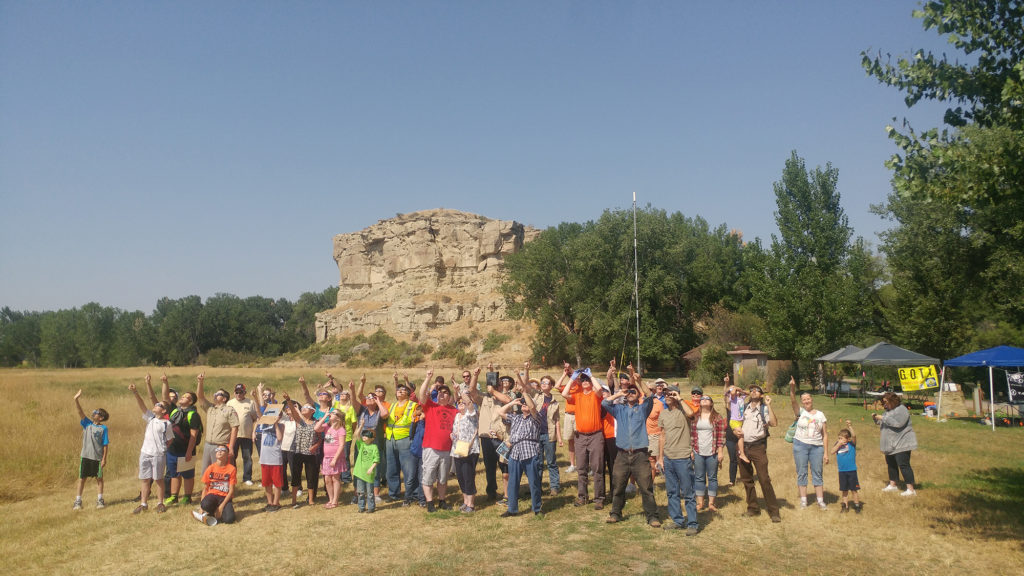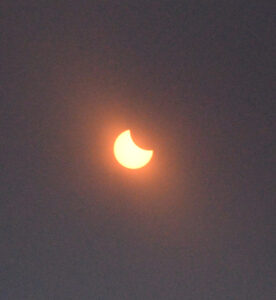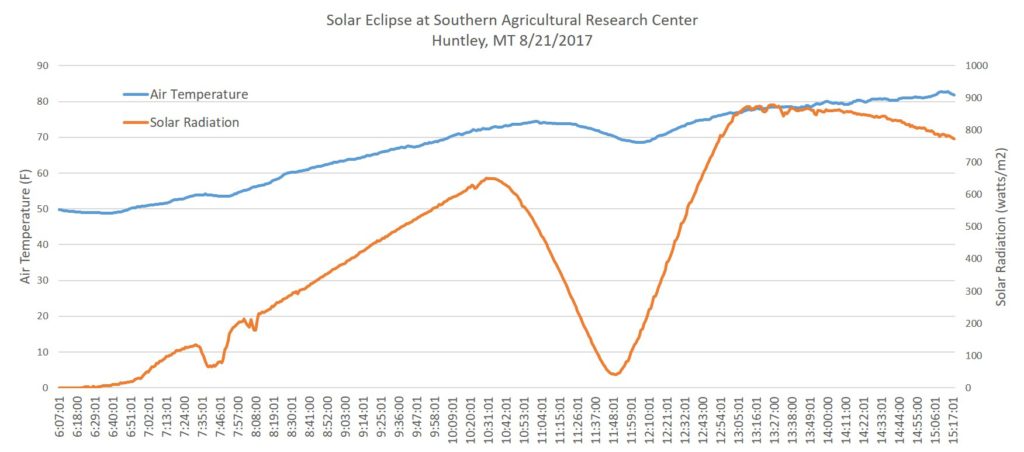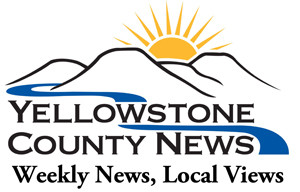
With their eyes protected by special glasses, a crowd gathered at Pompeys Pillar National Monument (behind group) to watch Monday’s solar eclipse. Ham radio operators used the eclipse to test how radio waves were affected the changes in solar energy. (Jonathan McNiven photo)
Originally published in the 8/25/17 print edition of Yellowstone County News
POMPEYS PILLAR — Monday’s solar eclipse wowed people who gazed up at the sky, but on the ground at Pompeys Pillar, ham radio operators from the Yellowstone Radio Club were listening for responses to their broadcasts at the national monument.
For Bob Hall, a ranger for the Bureau of Land Management and longtime ham radio operator, Monday’s solar eclipse was a mix of the mystical with pure scientific data.
“Hams, by their nature, have a scientific bent,” Hall said. The ham radio operators on Monday were part of a nationwide fabric transmitting and receiving both Morse code and voice transmissions, collecting data for Virginia Tech researchers.
The experiment was set up to find out more about how the interruption of solar radiation during an eclipse affects radio transmissions.
For Hall, it’s important that everyday citizens, not just PhDs in research labs, can contribute to the scientific base of knowledge.
“We kind of like to push the idea of citizen science,” Hall said. “The average citizen can contribute to real research,” and given his ranger assignment at Pompeys Pillar, doing it on public land makes it an even sweeter accomplishment.
The event drew dedicated eclipse viewers, veteran and new ham radio operators, Boy Scouts and a couple of tourists from Spokane, Washington, who had never heard of Pompeys Pillar, saw the highway sign and dropped in — then stayed to watch the eclipse.
On Monday morning, radio operators were waiting for bands to “open up” to allow their transmissions through.
Ron Glass of the Yellowstone Radio Club said a solar storm on Thursday, Aug. 17 knocked out radio transmissions on Friday, although conditions improved a little on Saturday.
Glass said improving technology is helping scientists learn more about space, and how sound waves travel. He said data from Monday’s transmissions may lead to better understanding how solar energy, or its absence, affect radio transmissions.

Beginning of the 2017 Solar eclipse that occurred on Monday August 21. The eclipse started at 10:21 AM and reached maximum eclipse possibility at 11:39pm and ended at 1:03pm. It reached 93% eclipse from Pompeys Pillar National Monument. (Jonathan McNiven photo)
Many people are familiar with how AM radio stations often can be heard some distance away at night, said Charlie Hanson of the Yellowstone Radio Club.
Many radio stations operate by line of sight, but ham radio sends a signal into the earth’s atmosphere.
“We’re blasting out a signal that is being picked up by what we call beacon stations all over the country,” Hanson said. “This is really a big deal.”
Data from Monday’s radio transmissions will be submitted from across the country to Virginia Tech. Some results may be published by the fall, Hanson said.
Local forecasts had been for about 93 percent coverage of the sun by the moon. On Tuesday, Kent McVay of the Southern Agricultural Research Center of Montana State University at Huntley said data generated at the research center during the eclipse indicated it was closer to 95 percent. Not a total eclipse, but close.
Solar radiation dropped from about 800 watts to 41 watts during the time the sun was obscured, McVay said.
Temperatures also dropped.
“We measured a 6 degree change” from 75 degrees to 69 degrees at the research center, McVay said. “It felt like evening. You could feel that drop.”

This graph provided by Kent McVay at the Southern Agricultural Research Center shows dips in solar energy and temperatures during Monday’s solar eclipse. (Image courtesy of Kent McVay)

